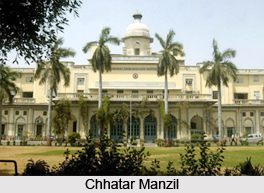 Chhatar Manzil complex, also known as them Farhat Baksh complex, is constructed in the style of the later Nawabi architecture in Lucknow. In the second phase of Nawabi architecture, constructed from 1800-1856, are those monuments which belong to the first half of the nineteenth century, before Awadh was annexed by the British. These monuments are characterised by a hybrid style, incorporating Indo-Muslim and European elements. The Chhatar Manzil is a Nawabi Palace complex completed by Ghazi ud Din Haidar. It was earlier built by Nawab Saadat Ali Khan in memory of his mother, Chhatar Kunwar. The complex consisted of the Greater and Lesser Chhatar Manzils, the Kothi Farhat Baksh built by Claude Martin, the Lal Baradari, Gulistan-i-Iram and Darshan Vilas.
Chhatar Manzil complex, also known as them Farhat Baksh complex, is constructed in the style of the later Nawabi architecture in Lucknow. In the second phase of Nawabi architecture, constructed from 1800-1856, are those monuments which belong to the first half of the nineteenth century, before Awadh was annexed by the British. These monuments are characterised by a hybrid style, incorporating Indo-Muslim and European elements. The Chhatar Manzil is a Nawabi Palace complex completed by Ghazi ud Din Haidar. It was earlier built by Nawab Saadat Ali Khan in memory of his mother, Chhatar Kunwar. The complex consisted of the Greater and Lesser Chhatar Manzils, the Kothi Farhat Baksh built by Claude Martin, the Lal Baradari, Gulistan-i-Iram and Darshan Vilas.
The Chhatar Manzil complex essentially comprised of a series of European houses with a central garden and smaller buildings like Baradaris and pavilions, covered passageways, gateways and walled areas. The Gomti River and the Khas Bazar formed the northern and southern edges of the complex. Ghazi ud Din Haidar completed the unfinished palace on the right bank of the Gomti, near Kothi Farhat Bakhsh. The palace was crowned by a golden pinnacle in the form of an umbrella. The unique feature gave its name to two palaces- the Ban Chhatar Manzil and the Chhoti Chhatar Manzil - built opposite one another. This pinnacle became so popular that almost all the later domed buildings were decorated with an umbrella in the form of the crown of Awadh, particularly Kothi Kaisar Bagh, Kaisar Pasand and Lakhi Darwaza. The Iranian carpets, wall paintings, mirrors, portraits and chandeliers which once adorned the palace are now missing. Both the Chhatar Manzils and the surrounding gardens were originally enclosed within boundary walls, but General Havelock destroyed them after crushing the freedom-fighters on 25 September 1857. The elegant marble tank is now buried under the metalled road built by the British.
The palace was occupied by several members of the royal family of Awadh, including the favourite Begums Malka Zamani, Kudsia Mahal and Malka Kishwar, mother of the last king, Wajid Ali Shah. After 1857, the British stripped the palace of all its costly furniture, decorations and hangings, which they sent to England. They converted the palace into the United Services Club with a library for senior British officials. Since 1950, the palace has been used by the Council of Scientific and Industrial Research and the Central Drug Research Institute.



















